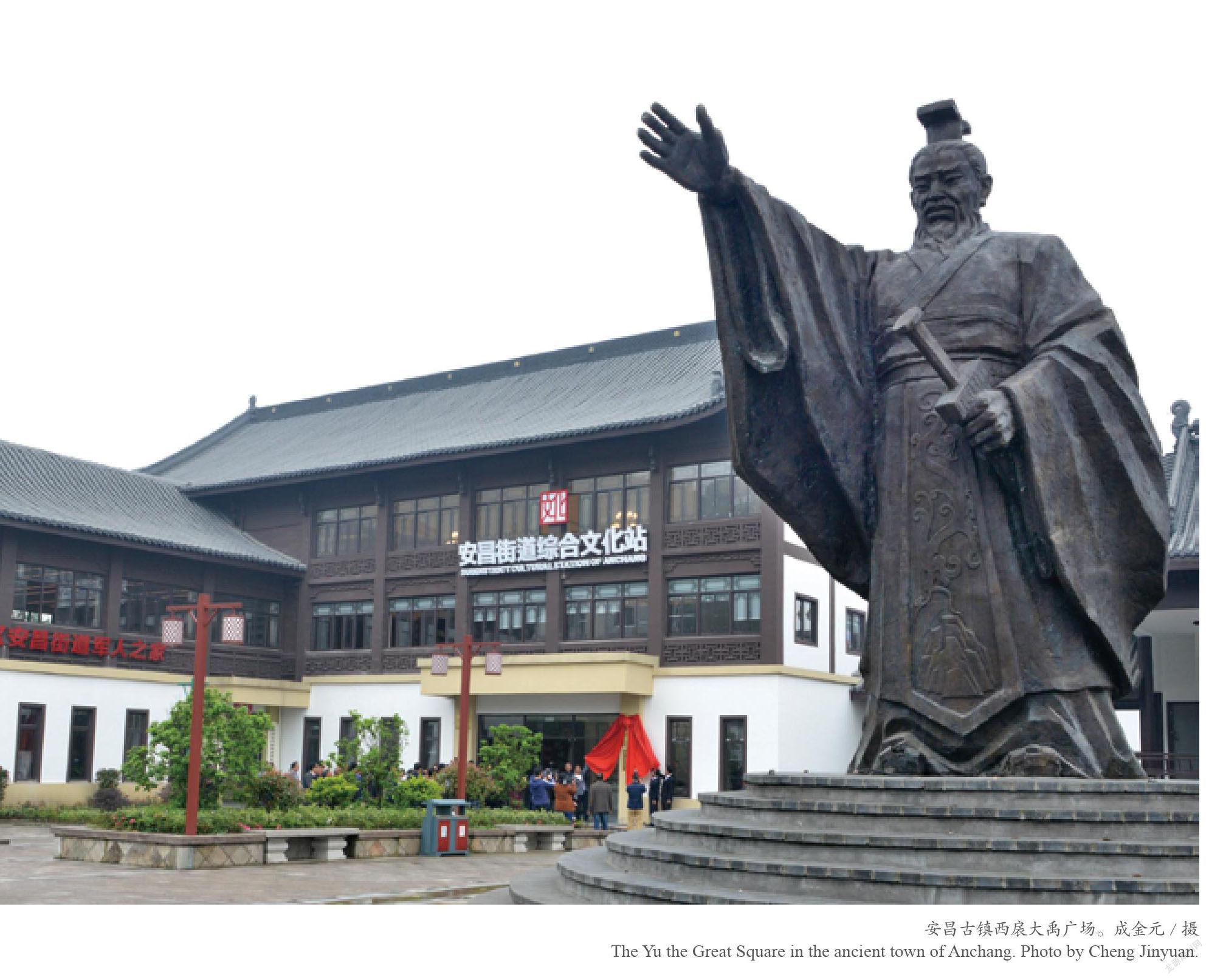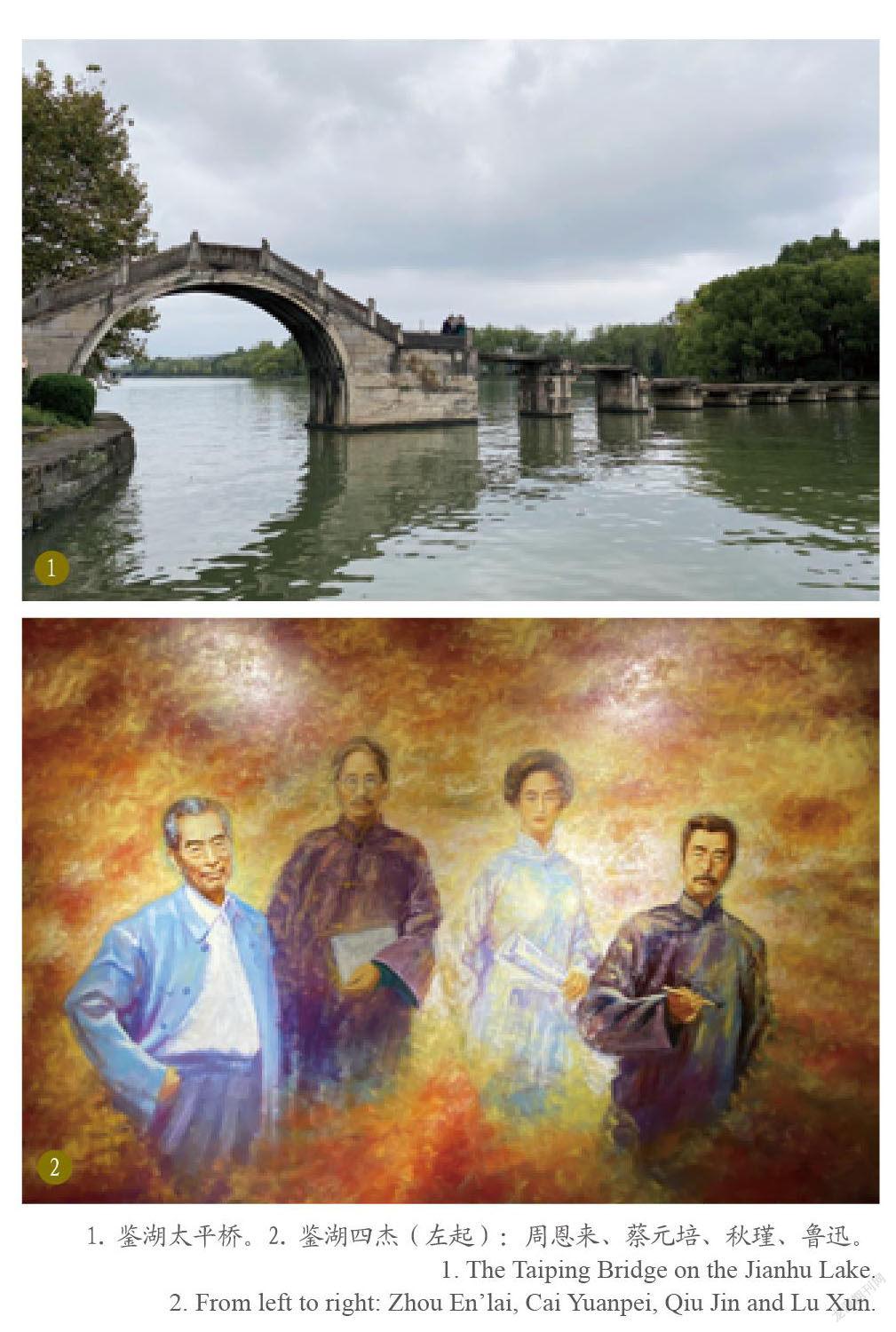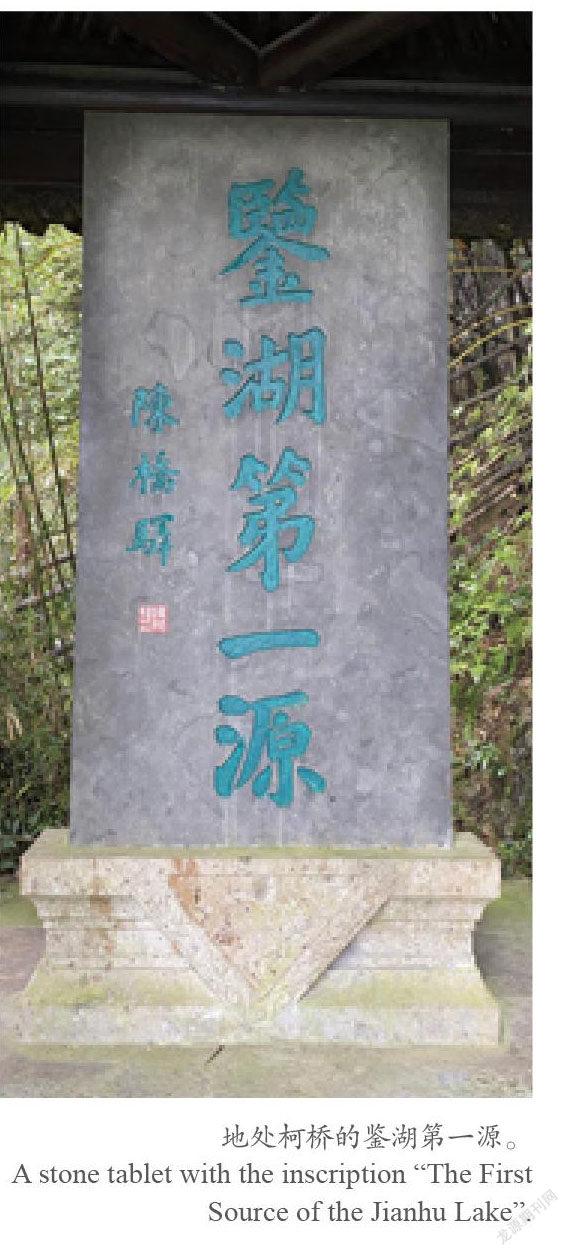从大禹与鉴湖说开去
陈富强



夏日的绍兴鉴湖艳阳高照,微风和煦,晴朗明媚,湖面水平如镜,湖水清澈见底。隐约可看见水底涌动的水草,岸上柳树迎风飘舞,坐上画舫看绍兴鉴湖,是最惬意不过的事情。画舫驶离绍兴鉴湖码头,可眺的湖面已被分割成不规则的若干形状,说是宽阔的水道也可以,水道两侧,布满建筑,以商住楼为主,我稍稍有些失望。驶过其中一段,沿湖砌墙,墙绘主题,多与鉴湖有关,富江南特色。令我惊奇的是,在墙与水面不足一米的空地上,居然长满绿油油的青菜。我有些诧异,种菜人是如何发现,并且走到这片狭长的土地上的?又是如何播种施肥的?
绍兴春秋战国时期称越国,古越文化博大精深,我一直想找找大禹与鉴湖的关系,但资料甚少,只看到一句:历史上的鉴湖,可追溯到大禹治水的传说和古越国的水利建设时期。大禹在绍兴地区最著名的传说和大禹的陵墓,恰好在鉴湖两端,相距不远,并且都在鉴湖八百里范围之内。
先来说大禹在绍兴的传说。相传大禹在治水之际,认识了一位涂山氏族的女子,一见钟情,这位女子也深深地爱上了禹。禹忙于治水,涂山氏女在家天天盼望夫君大禹回来。在家盼望不到,又跑到涂山山南的山坡上去等候。一天天过去了,涂山氏女望穿了秋水,还是未见禹回来。她不禁长叹一声,吟咏出这样的一句:候人兮,猗!这四个字,据说就是中国的第一首女声独唱,也是第一首南方情歌。
涂山氏族是夏族的始祖神,夏族就是日后建立中国第一个王朝夏的一个部落集团。东汉赵晔 《吴越春秋 · 越王无馀外传》:“禹三十未娶,行到涂山,恐时之暮,失其度制,乃辞云:‘吾娶也,必有应矣。’乃有白狐九尾造于禹。禹曰:‘白者,吾之服也。其九尾者,王之证也。’涂山之歌曰:‘绥绥白狐,九尾庞庞。我家嘉夷,来宾为王。成家成室,我造彼昌。天人之际,于兹则行。’明矣哉!禹娶涂山氏族一女子,谓之女娇。取辛壬癸甲,禹行。十月,女娇生子启。启生不见父,昼夕呱呱啼泣。”这段记载,似乎可以证明大禹在绍兴地区留下的印迹,也告诉我们,涂山氏也称女娇。
涂山之歌在《先秦诗鉴赏辞典》中有记载,以《涂山歌》名,收录四句:绥绥白狐,九尾庞庞。成于家室,我都攸昌。如果翻译成白话文,是这样:孤孤单单走来的白狐狸,九个尾巴毛茸茸又粗又长。大禹和涂山女结为连理,我们这里将永远发达兴旺!
大禹娶涂山氏为妻,在绍兴的传说,是在古镇安昌以东的涂山。这座山现在依然屹立,我们称它西扆山,山不高,也不绵延,如果从远处俯瞰,稍显孤单,从平原上拔地而起。每年清明,我都会和家人上山扫墓,我的父亲和母亲,合葬在西扆山南坡,地处山腰,从墓地再往上走,至山顶,可眺涂山四周,当年,鉴湖湖面宽广的时候,也可见湖水荡漾。我一直庆幸,为父母的来生选在涂山,与大禹夫妻为邻,再也没有比这更美好的了。
相传,涂山是大禹召集诸侯商议朝政大事的地方,据《尚书 · 舜典》记载:帝舜之时,大禹为司空,皋陶作士,伯益为虞。禹即帝位后,皋陶、伯益迭为首辅,涂山氏成了夏后氏最倚重的力量。为了进一步获得妻族的支持,大禹便携同女娇,在涂山召开了紧急军事会议,准备与共工决一死战。《左传》也有记载:“禹会诸侯于涂山,执玉帛者万国”;《史记》则云:“夏之兴也以涂山”。正是涂山之会,确立了禹的天下共主地位。
而涂山氏的家,则在山南。大禹娶女娇的传说,在安昌口口相传,年长者,都能说出个子丑寅卯。童年时,我常常跑到城隍殿,那儿有一座高高的拱桥,夏天在桥上乘凉的人,有一位说书水平超群的,他不光说四书五经三国水浒,也能讲大禹治水娶涂山女娇。我无比钦佩他的记忆力,很想问问他,怎么知道这么多?成年后我才明白,他所说的,除了古书上记载的,大多是民间传说。传说在民间的无穷力量,简直所向披靡。
然后,关于大禹娶妻的传说,不仅在安昌有,在安徽和江西也有。特别是安徽,据称建有涂山氏祖庙,发现“涂山氏国”遗址。安昌人,特别是西扆村的村民在听说这个考古事件后,颇有些不以为然。他们的理由很简单,涂山在安昌,怎么也搬不走。安昌镇也早早地在涂山北的西扆村建起了大禹广场,广场正中,立起一座巍峨的大禹雕像,每年都有祭大禹仪式。此外,大禹陵就在距离安昌三十里之外的会稽山麓,树高千丈,叶落归根,大禹葬于此,就是最好的实证。
我认同一些学者的观点,涂氏跟绝大多数姓氏一样,当初也是从中原迁徙而来,而不是在江南土生土长的,像《姓氏族谱笺释》就认为:“系出涂山氏;晋新吴侯涂钦渡江南至豫,为东南涂之氏之祖。”所谓“涂山氏”,很可能是上古时期一个诸侯的名称,有关当时涂山氏的所在地,很久以来众说纷纭。我觉得,各说各的,也無妨。
不过,绍兴的大禹陵终究是独一无二的。
最早的文字记载可追溯到始皇三十七年(公元前210年),十一月,秦始皇东巡狩,上会稽,祭大禹,登秦望山,眺南海,感叹之余,命宰相李斯撰文刻于石上以歌颂秦始皇嬴政,故又名“李斯碑”。碑文字属秦小篆,是秦统一六国后颁行的文字。
汉武帝元朔三年(公元前126年),司马迁上会稽,探禹穴。所谓“禹穴”,也就是埋葬大禹的地方。或言大禹陵寝在今“大禹陵碑亭”下面。大禹陵寝至今没有挖掘,是上策。大禹终究是一个传说,传说在,大禹就在。
大禹陵由禹陵、禹祠、禹庙三部分组成。禹陵在中,禹祠位于禹陵南侧,祠外北侧有“禹穴”碑。祠内有“禹穴辩”碑,大禹陵碑亭北侧,顺碑廊而下即为禹庙。陵区坐东朝西,从大禹陵下,进东辕门,自南而北的建筑依次为照壁、岣嵝碑亭、棂星门、午门、祭厅、大殿。整个建筑群高低错落,山环水绕。
以大禹陵为代表,大禹在绍兴留下的遗踪随处可见。毗邻安昌的另一座古镇夏履镇,也与大禹有关。相传大禹治水经过这里,他的一只履被洪水冲走,老百姓为了纪念大禹治水的功绩,在他失履的地方造了一座桥,名曰“夏履桥”。再比如,大禹陵的守陵村,即禹陵村,有200个村民姓姒,而全国的姒姓后裔也不过几千人。
更富有诗意的故事,出现在剡溪。绍兴嵊州境内的剡溪,堪称大禹治水的典范之作,著名的“禹疏了溪”就发生在剡溪。大禹改堵为疏,“三过家门而不入”,终于治水成功,后世称“禹疏了溪”。了溪,也就是后来的剡溪,为今天曹娥江的上游。李白赋诗:“湖月照我影,送我至剡溪。”又说:“此去不为鲈鱼脍,自爱名山入剡中。”杜甫也叹:“剡溪蕴异秀,天姥引归帆。”
我曾在剡溪泛舟,眺望天姥山,驚叹于大自然的巧夺天工,也钦佩诗人们的天才博学,落笔有神,更为大禹治水在剡溪留下的印记而感动不已。
画舫经过鉴湖的一段古纤道,这段纤道是时间的证明,连接着历史与现实。作为传说中黄帝铸镜而得名的鉴湖,又有镜湖之称,其实就是我国长江以南著名的水利工程,全盛时面积近200平方公里,而我乘坐的画舫经过的水域,则是古鉴湖淹废后的残留部分。我再也看不到八百里鉴湖的浩渺,但连接着鉴湖的传说,却让我眺望更为遥远的时空。
返回鉴湖码头途中,画舫略有加速,湖上风光正好,微风轻拂,正应了王羲之“山阴道上行,如在镜中游”,怪不得连贺知章和陆游也要终老于此。画舫又经过那片狭长的菜地,恰有一种菜的人,贴着墙根,往菜地上浇水,他的水桶里,装满了鉴湖的水,他的眼里,只有他的这片青菜地,但他只需抬眼,就是鉴湖。如果再往远处看,他看到的,应该就是辽阔的八百里鉴湖了。
泊舟上岸,夜宿鉴湖大酒店。夜已深,竟未能入眠,下楼在大堂徘徊,一面墙上的巨幅油画,映入眼帘,画上四人,神态传神,分别是鉴湖人鲁迅、蔡元培、秋瑾和周恩来,隐隐觉得,少了谁,凝神良久,才想到,东汉永和五年,会稽太守马臻纳山阴、会稽两县36源之水为湖,是为鉴湖。贺知章和陆游也择鉴湖终老,他们没能出现在画上,想必是画幅不允,但晚年的诗人贺陆,已得人生真经,早有诗作传世,与鉴湖融为一体。鉴湖跨湖桥下,马太守也有墓,有庙,供百姓祭扫。由此我想,若能在鉴湖边,幽静处,劈一块地,种几畦菜,如果再有一间茅屋,半亩茶园,三两知己,与先贤们毗邻而居,那真是人间逍遥。
Yu the Great, the Jianhu Lake and Other Stories
By Chen Fuqiang
It is a sunny and breezy summer day. Traveling on the Jianhu Lake in Shaoxing city, one can even see the bottom of the mirror-like lake, with water plants swinging to and fro and willows on the banks fluttering in the wind. Sitting in a pleasure boat at this time is perhaps the most enjoyable. On the sides of the lake stand a slew of buildings. One section of the wall which has been erected along the lake has been painted with all sorts of pictures, mostly on the Jianhu Lake itself, full of Jiangnan (south of the Yangtze River) charm.
During the Spring and Autumn (770-476 BC) and the Warring States (475-221 BC) periods Shaoxing was known as the State of Yue (2032-222 BC). With the extensive and profound culture of ancient Yue, I have been trying to find the connections between Yu the Great and the Jianhu Lake, but the documentation is few and far between. Indeed, only one piece of information seems to be available: the origin of the lake can be traced back to the taming of floods by Yu the Great, as well as the efforts of the State of Yue on water conservancy. It so happens that the most widely known legend of Yu the Great in Shaoxing took place and his mausoleum lies just at both ends of the lake, within a radius of 400 kilometers.
So the tale goes like this. When Yu the Great went about controlling the floods, he met a lady of the Tushan clan, and they fell in love at first sight before tying the knot. But Yu was so busy with his work that he couldn’t come back for a long time. The Tushan lady was looking forward to his returning home day after day. Not satisfied just staying at at home, she went up to the south slope of the Tushan Mountain to look far and beyond for any trace of her husband. Days passed, yet Yu the Great still did not return. She couldn’t help but sigh, uttering a single line: “Oh, I am waiting for him!” This, some scholars believe, is China’s first poem by a female author and the first love song in the south.
There is a mythical element in their marriage as well. According to a number of classic Chinese texts, Yu the Great still hadn’t got married when he was thirty years old. At the time, he passed by the Tushan Mountain on his way to tame floods. Yu the Great was afraid that he would not be able to fulfill his moral obligation that required a man to marry by the age of thirty, recounted the texts, and he therefore asked for an omen for him to marry. Shortly afterwards, it is said, a white fox with nine tails appeared before him. To Yu the Great, that was exactly the sign that he prayed for, as he explained this through the so-called “Song of Tushan”, which has since been recorded in numerous poetry collections: The white fox comes alone, with nine bushy and long tails. When Yu the Great and the lady of Tushan get married, we will be prosperous forever and ever!
In fact, the Tushan clan is believed to be the ancestral gods of the Xia tribe, who later established China’s first dynasty, the Xia dynasty (ca. 2070-1600 BC).
According to the narrative passed down throughout generations in Shaoxing, Yu the Great and the lady from the Tushan clan married on the Tushan Mountain, now located in the east of the ancient town Anchang in Shaoxing. Neither too high nor a long mountain chain, it is still standing today, which is known as the Xiyi Mountain. But if you look down at it from a distance, the mountain appears a little lonely, rising as if from nowhere out of the plain. Every year during the Qingming Festival or the Tomb-Sweeping Festival, I would visit the graves of my parents with my family on the south slope of the Xiyi Mountain. From the mountainside, where the cemetery sits, if you go further up, to the top of the mountain, you can have a panoramic view around it. I have always been glad that I have chosen the “next life” of my parents here in the mountain, with Yu the Great and his wife as neighbors. There is no better life than this.
In addition, the Tushan Mountain is said to be the place where Yu the Great once discussed matters of national importance. Since Yu the Great ascended the throne, the powerful Tushan clan had become a great source of support for him. To further consolidate their relationship, he convened a special miliary council on the Tushan Mountain and declared his intention to fight Gongong, the water monster who reigned terror in that era. The meeting has been documented in various ancient texts, including the Book of Documents, the Zuo’s Commentary as well as the Records of the Grand Historian.
Indeed, the tale of Yu the Great and his marriage is so well-known that the local elderly in Anchang can tell the story in vivid details. However, Shaoxing is not the only place where the folktale spreads; it has been circulated in the provinces of Anhui and Jiangxi, too. In Anhui, for example, the ancestral temple of the Tushan clan and the ruins of a so-called “Tushan Kingdom” were said to have been found. Some experts argue — which I agree with — that the Tushan clan was probably not native to the Jiangnan area but migrated from central China.
Nonetheless, the Mausoleum of Yu the Great in Shaoxing is the one and only.
The earliest written records of the mausoleum can be traced back to 210 BC, the 37th year of the reign of Emperor Shihuang (259-210 BC), when he visited Kuaiji (present-day Shaoxing) and held sacrificial rituals for Yu the Great. His words and deeds were written down and inscribed on a stone tablet by Li Si (?-208 BC), the emperor’s righthand man. In 126 BC, Sima Qian (145 or 135 BC-?), author of Records of the Grand Historian, went to Kuaiji and explored the burial site of Yu the Great.
The Mausoleum of Yu the Great is consisted of three parts, the mausoleum, the shrine and the temple. Apart from it, traces of Yu the Great can be seen everywhere in Shaoxing. For instance, an ancient town called Xiaji township was so named because Yu lost one of his wood boots (a “ji”) here when he was working to control the floods. A bridge, Xiaji Bridge, commemorating the incident was also built in the place.
Then the Shanxi River was lauded as a model of Yu’s efforts, where he chose to dredge it instead of damming and blocking the water flow. It was working along this river that Yu the Great was said to “have passed his own home three times without entering once”. Later, quite a few poems were composed on the Shanxi River, including those by Li Bai (701-762) and Du Fu (712-770), who are considered the best Chinese poets.
Leaving the boat, I have stayed in a local hotel for the night. It is already late, but I cannot fall asleep, so I decide to go downstairs and have a stroll in the lobby. A large oil painting on a wall comes into sight, with four prominent contemporary figures intimately connected to the Jianhu Lake: Lu Xun (1881-1936), Cai Yuanpei (1868-1940), Qiu Jin (1875-1907) and Zhou Enlai (1898-1976). He Zhizhang (659-744) and Lu You (1125-1210), two of ancient China’s best-known poets, also chose the Jianhu Lake as the place of retirement. If I could have a small plot of land and grow some vegetables in the quietude by the lake, with a thatched cottage, a half mu of tea plantation and a couple of bosom friends, and with all the forebearers as my neighbors, it would be truly a world of bliss.
——绍兴市公安局柯桥区分局安昌派出所侧记(安昌派出所摄影 本刊编辑部报道)
——以《全唐诗》为文本

